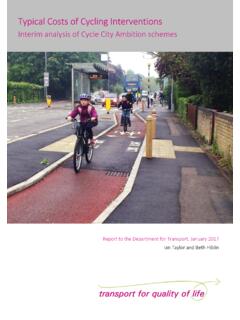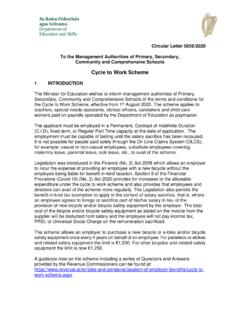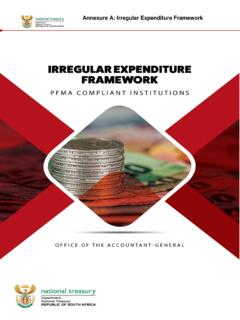Transcription of Chapter 1. AN OVERVIEW OF PUBLIC EXPENDITURE …
1 Chapter 1. AN OVERVIEW OF PUBLIC EXPENDITURE MANAGEMENTThis Chapter has two objectives. First, it places PUBLIC EXPENDITURE management (PEM)in the broader context of the role of the state, good governance, macroeconomic policy, andthe changing environment (especially in information and communication technology). To viewPEM only through a technical prism would fundamentally distort the picture. Second, thechapter provides a quick run-through of the entire EXPENDITURE management cycle . Thischapter can therefore serve as a map of the book for the thorough reader, as well as a stand-alone sketch of the key issues for the busy PUBLIC official (who should also read the last sectionof the concluding Chapter 17).
2 For both types of readers, we hope this brief OVERVIEW will atleast bring home the point that the management of PUBLIC EXPENDITURE is neither a purelytechnocratic issue nor suitable for simple quick fixes, on the one hand, yet is always amenableto some practical improvement, on the OBJECTIVES AND CONTEXT OF PUBLIC EXPENDITURE meaning and role of PUBLIC EXPENDITURE managementThe budget should be a financial mirror of society's economic and social choices. Inorder to perform the roles assigned to it by its people, the state needs, among other things, to:(i) collect resources from the economy, in sufficient and appropriate manner; and (ii) allocateand use those resources responsively, efficiently and PUBLIC expendituremanagement pertains only to (ii), and is thus only one instrument, albeit a key instrument, ofgovernment policy.
3 Hence, although this book focuses on PEM, readers are advised to alwayskeep in mind the integral relationship between revenue and EXPENDITURE between themoney collected directly or indirectly from the people (and, in most developing countries, fromaid donors), and the use of that money in a manner that reflects most closely the people Also, close cooperation between tax and budget officials is a must for manyareas, , budget forecasting, macroeconomic framework formulation, trade-offs betweenoutright expenditures and tax question of the mechanisms by which the people s preferences are ascertained,political accountability is obtained, and government action is monitored, is central to politicsand very important.
4 But outside the scope of this analysis (as well as beyond the mandate ofinternational development institutions).3 Nevertheless, the analysis and discussion throughoutthis volume is largely predicated on the existence of some government legitimacy, somemeasure of legal and political accountability, and some separation of powers among theexecutive, legislative, and judicial branches of government. As a logical extreme, it would intheory be conceivable to improve PEM in a kleptocracy designed exclusively for the benefit ofthe power elite (as for example in Mobutu s Zaire), but it would certainly not assist the country seconomic development.
5 (The elements of good governance are summarized in the nextsection.)That said, PUBLIC EXPENDITURE management is instrumental in nature. There is anecessary distinction between the EXPENDITURE policy question of what is to be done, and theexpenditure management question of how it is to be done. It is true that attempts to set hardboundaries between policy and implementation eventually lead to unrealistic policies, ad hocimplementation and, over time, both bad policy and bad implementation. However, thedistinction between the soundness of PEM procedures and processes and the goals that theyare meant to achieve remains very important.
6 Among other things, the mechanisms,techniques, skills, and data required for good PEM are different from those needed toformulate good Accordingly, the analysis and discussion herein is generally applicableregardless of the economic orientation, strategic priorities, or policy choices of the governmentin the same time, however, it is fundamental to realize that PUBLIC expendituremanagement is country-specific. PEM approaches and recommendations must be solidlygrounded on the economic, social, administrative, and implementation capacity realities of thespecific country.
7 Like any other technology from water pumps to agricultural fertilizers toconstruction PUBLIC EXPENDITURE technology must be appropriate technology, in terms of (i)local factor endowments, (ii) local institutions, and (iii) real local needs. Hence, any PEMinnovation generated abroad must be carefully analyzed in the light of the local context andrejected, adopted, or adapted as needed. Particularly important for the analysis of applicabilityis an evaluation of the country s institutional framework and the availability of relevant andreliable data and sufficient skills.
8 As an analogy, the scarcity of licensed builders, heavy3construction equipment, and firm soil in a particular location doesn t necessarily mean thathouses shouldn t be built there, but certainly counsels against the building of skyscrapers particularly when they may not be wanted in the first place. At the very minimum, external andnational change agents must be mindful of the Hippocratic injunction First, do no harm (aswell as today s colloquialism If it ain t broke, don t fix it ). policy context and the objectives of policy contextThe key goals of overall economic policy are conventionally defined as growth, equity,and It has long been understood that these three goals are complementary over thelong-term.
9 Economic growth provides the resources needed for poverty reduction, but cannotbe sustainable if it is not accompanied by sufficient stability and equitable policies. Unstableeconomic and financial circumstances are inimical to growth, and typically hurt the poor stability in a context of persistent economic stagnation and poverty is hardly a desirableoutcome. In the short-term, however, these goals may be mutually conflicting, and a soundresolution is required (and hence a robust institutional mechanism) that takes all three intoconsideration in a coherent policy three key objectives of PEM6As noted, PUBLIC EXPENDITURE management is instrumental in nature.
10 As a centralinstrument of policy, it must pursue all three overall economic policy goals. Financial stabilitycalls, among other things, for fiscal discipline; economic growth and equity are pursued partlythrough allocation of PUBLIC money to the various sectors; and, most obviously, all three goalsrequire efficient and effective use of resources in practice. Hence, the three goals of overallpolicy translate into three key objectives of good PUBLIC EXPENDITURE management: fiscaldiscipline ( EXPENDITURE control); allocation of resources consistent with policy priorities( strategic allocation); and good operational In turn, good operationalmanagement calls for both efficiency (minimizing cost per unit of output) and effectiveness(achieving the outcome for which the output is intended).
















